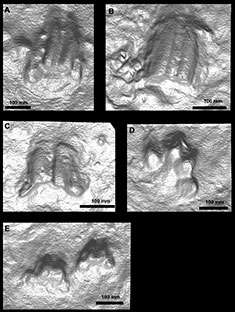Fossilised swimming hippos could help us understand dinosaur footprints

Fossil swim tracks in Kenya left by hippopotami may help scientists understand how the largest dinosaurs moved in water.
The study is the first time that researchers have described the traces left by a large mammal as it swims.
The scientists hope that the 1.4 million year old tracks left by hippopotami as they walked across the bottom of a shallow pool will lead to a better understanding of other controversial swim tracks.
'It's amazing to see how hippos move under water. They can't swim so they submerge themselves and thrust off the bottom of a water body to get motion. They bottom walk, or punt, which leaves remarkable swim traces,' says Professor Matthew Bennett of Bournemouth University, lead researcher on the study.
Unlike a trail of footprints left by an animal walking across sand or mud, the fossil hippo tracks aren't uniform.
'The same animal can leave lots of traces that look very different, it just depends on the way its feet make contact with the ground,' Bennett says. 'A hippo has four toes and sometimes they come down vertically so you just get prod marks, or other times it puts all four toes flat on the ground and pushes off. In the ancient fossil record you might think such a diverse range of traces would be made by more than one animal producing, but actually it's just one.'
'The big sauropod dinosaurs may have moved in water by either walking on the bottom or thrusting down like a hippo, so the secondary value of these hippo tracks is that they may help us to understand the locomotion styles of large dinosaurs in water,' he explains.

At the moment scientists disagree on how to interpret several dinosaur footprint sites that involve swim traces.
'There's a tendency to explain a lot of dinosaur tracks as being made by dinosaurs walking along the bottom of shallow water bodies but modelling work has challenged this,' explains Bennett. 'We hope our work helps people understand what a swim trace definitely looks like and the range of different types of track that result.'
The team uncovered the footprints at Koobi Fora (Kenya), as part of an archaeological excavation looking for hominin footprints. They digitally recorded them using an optical laser scanner to produce a 3D model. This has helped them to see what sort of swimming, walking or running movement an animal would have to be making to create the tracks.
'We understand much more now about how these animals were moving and how a mammal bottom walks in a microgravity environment, and now we can say how those range of motions are manifest as tracks on a muddy bottom,' says Bennett.
The hippos swimming in lakes across Kenya were quite common in the past and would have looked similar to hippos today, but pygmy hippos were also known to exist in the area.
'One thing we don't know for certain is how many hippos were involved in leaving this large number of swim traces as you can get a very small group of hippos who leave lots of traces by swimming in circles, a bit like the BBC logo advert,' Bennett says.
The study was published in Palaeogeography, Palaeoclimatology, Palaeoecology.
More information: Matthew R. Bennett, Sarita A. Morse, Peter L. Falkingham (2014) "Tracks made by swimming Hippopotami: An example from Koobi Fora (Turkana Basin, Kenya)." Palaeogeography, Palaeoclimatology, Palaeoecology, DOI: 10.1016/j.palaeo.2014.04.021
Journal information: Palaeogeography, Palaeoclimatology, Palaeoecology
Provided by PlanetEarth Online
This story is republished courtesy of Planet Earth online, a free, companion website to the award-winning magazine Planet Earth published and funded by the Natural Environment Research Council (NERC).



















